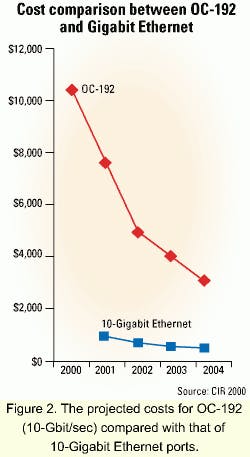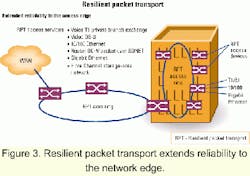Extending reliability and survivable optical rings to the access network
Innovative network technologies like resilient packet transport are enabling carriers to provide flexible, bandwidth-intensive services via access networks.
JAY SHULER and KEN LANCASTER, Luminous Networks
Service providers are entering a new era in delivering services to their enterprise customers. As fiber access becomes a reality, carriers can now overcome one of the last major bandwidth obstacles: the rigid and expensive private-line circuit. Private-line circuits have been used for LAN-to-WAN connectivity since the beginning of the LAN itself. A vast majority of business and government and educational institutions still rely on DS-0 (64-kbit/sec), fractional T1 (1.554-Mbit/sec), or T1 access into the Internet or WAN.
A few very large enterprises can justify the expense of DS-3 (45-Mbit/sec) connections, but these users are the exception.
A new era is now emerging in which metropolitan-area carriers and their customers will enjoy the "new economics" brought by Ethernet, with its simplified operations and lower equipment costs, and by the resilient packet ring (RPR) protocol now under development within the IEEE 802.17 working group. These technologies represent a new approach for access networks due to lower costs, streamlined operations, and service flexibility (see Figure 1).
Until recently, carriers and their end customers were victims of the high cost of fiber deployment and SONET technology. Throughout the 1990s, deployment of both fiber and SONET technology was primarily limited to very high traffic applications, such as end-office trunking between the urban central offices of the incumbent local-exchange carriers and the interoffice long-distance links operated by the interexchange carriers.The cost of deploying fiber and SONET/SDH terminals to most urban office buildings and suburban office parks-and especially to small- to medium-sized business locations-has been prohibitive. In fact, it is estimated that only 5%-7% of urban office buildings have direct fiber access.
However, this dearth of both fiber and high-bandwidth services will soon become a thing of the past. New technologies and today's competitive market dynamics are enabling delivery of traditional voice and circuit services, as well as affordable, highly reliable, native Ethernet access services at rates of up to 1 Gbit/sec-all over a converged, packet-based network infrastructure. For example, one carrier is already offering 100-Mbit/sec Ethernet service for about the same price as previously charged for a few T1s.
RPR is an emerging standard now under development in the IEEE 802.17 working group. This protocol promises to revolutionize the MAN. One version of this standard, called resilient packet transport (RPT), is a superset precursor of RPR that includes synchronized, stratum-timed transport of TDM circuits and other enhanced capabilities.
Today, cost pressures and the changing nature of enterprise networking are forcing enterprise customers to seek flexible "bandwidth-on-demand" solutions that better address their actual corporate traffic patterns. Most corporate traffic does not follow
the static, rigid bandwidth increments imposed by the circuit-switched interfaces used to access the WAN. Constant-rate service interfaces such as T1/E1 are not designed to accommodate the bursty, dynamic nature of corporate data traffic.
These legacy services cannot be provisioned with real-time velocity to meet the changing requirements of enterprise locations, due to the inflexible nature of the underlying SONET/SDH technology. Although these solutions once provided highly reliable transport for private-line and legacy TDM services, they simply are not optimized for the IP and Ethernet world of today.
New packet-based optical access solutions enable per-port, time-based provisioning of traffic for flexible bandwidth-on-demand services. A key advantage of RPT is its ability to extend per-port bandwidth-management capability to packet-based services, while reliably accommodating traditional TDM services. For example, a native Ethernet service can be provisioned on demand for bandwidth requirements or committed information rate and variables such as burst rate, class-of-service treatment, and protection status. An efficient hardware solution enables RPT to extend far into the access network-even directly to the corporate LAN demarcation point.
Another key market dynamic facing access end users is the ubiquitous deployment of Ethernet and IP. The battle of the LAN and the campus (and soon the WAN) is now over-IP and Ethernet are the victors.
Today, Gigabit Ethernet is clearly the emerging standard for LANs globally. According to Communications Industry Researchers Inc. (Charlottesville, VA), the growth of Gigabit Ethernet ports will increase from 4.6 million ports in 2000 to more than 48 million ports in 2004.
As 100- and 1,000-Mbit/sec Ethernet becomes ubiquitous among enterprise LANs, it's inevitable that access providers will have to accommodate customers via these native service interfaces.The rapid deployment of this technology throughout LAN/campus environments enables significant cost reductions based on volume production of Gigabit Ethernet technology. For example, the price of Gigabit Ethernet and 10-Gigabit Ethernet ports will always be substantially lower than a comparable SONET port such as OC-48 (2.5 Gbits/sec) or OC-192.
Figure 2 illustrates this disparity with a forecast of two 10-Gbit/sec service interfaces: OC-192 and 10-Gigabit Ether-net. Many new carriers raised millions of dollars in capital to address this emerging access market. Even incumbent carriers are now investigating and testing solutions for new access services like Fast Ethernet and Gigabit Ethernet.
A tremendous amount of excitement has been generated in the area of RPRs. The IEEE 802.17 working group has been chartered to develop standards for this innovative optical access protocol. Funda-mentally, the RPR protocol will provide a packet-based optical ring solution with the reliability and survivability found in today's SONET rings. The protocol is basically an enhanced Ethernet protocol that uses a new Layer 2 media-access-control frame format and a new set of control messages to add such features as auto-matic topology discovery, link and node status and protection, and management.
RPR is Layer 1 and Layer 3 independent, accommodating multiple services over multiple physical layers and media. Key benefits of RPR include full use of ring bandwidth (versus the wasted bandwidth allocation of 50% protection bandwidth, as with SONET), service restoration within 50 msec of fiber cut or nodal failure, and spatial reuse of bandwidth between node spans. RPR overcomes the expense, inefficiency, and inflexibility of circuit-switched SONET/SDH-while adding to Ethernet ring topology support and fast protection switching.
Other technologies targeted for the access network-and likely to be accommodated in RPR-include differentiated services (DiffServ) for quality of service (QoS) and Multiprotocol Label Switching (MPLS) for traffic engineering and service separation. These tools are vital in supporting services such as circuit-emulated TDM, premium data, or delay-sensitive voice and video. With the shift in network traffic from circuits to data, these technologies are optimized for the majority of traffic, while still accommodating the carriers' high-revenue, high-profit circuit services.
SONET continues to dominate access networks with the importance of voice and private-line traffic and the need for controlled delay and jitter, as well as Stratum synchronization to support these services. That also accounts for the high interest in RPR, evidenced by such organizations as the RPR study group, the IEEE working group, and the RPR Alliance. Products based on RPT, a superset of RPR, are currently being shipped. RPT has all of the fundamental capabilities of RPR, but adds enhanced DiffServ QoS and MPLS and is unique in providing Stratum timing distribution over the asynchronous ring for synchronized TDM circuit services.
RPT accomplishes sync distribution via the injection of a unique 10-bit control character every 125 microsec into the 8B/10B physical layer. This character can be injected into any part of the RPT frame and is only observed by the ring nodes as a timing character. When operating over the SONET/SDH physical layer, RPT takes its synchronization from the SONET/SDH framing, but dispenses with the circuit-switching layer. This innovative approach results in highly accurate synchronization of up to 254 nodes on a common ring.
Local Stratum/Global Positioning Satellite sources or inbound circuits such as T1 can serve as external timing sources. This feature is crucial for access networks that can now support delay-sensitive services, such as private-branch-exchange T1 trunks via low-cost Ethernet access devices located at customer premises. These devices enable deployment much closer to the end customer and more cost-effectively than expensive SONET or ATM edge devices. With RPT, the reliability found previously in the interoffice SONET network can be extended to the actual LAN access point. Survivable rings and true QoS are extended to the customer's demarcation point.
The reliability of SONET rings can be extended to the actual customer premise with low-cost RPT-based technology (see Figure 3). Core rings flow seamlessly into access rings that extend throughout the customer buildings. RPT goes well beyond SONET's limitation of 16 nodes per ring, allowing up to 254 RPT nodes on a single ring. That enables deployment of dozens of access devices within a single building or campus while maintaining the reliability standards found in SONET/SDH rings (sub-50-msec network restoration in case of a fiber cut or nodal failure).RPT enables all services to share a common, converged infrastructure, thus streamlining the network while ensuring the QoS required for services such as voice and broadcast video. Previous attempts at service consolidation required using both SONET and ATM technology to ensure reliability and QoS required for multiple services. That has proven too costly for the access network, especially at the network edge or customer premise. Now, simple IP/Ethernet solutions can significantly reduce maintenance, capital, and operational costs by eliminating the SONET and ATM management planes.
Since it is packet-based, RPT enables carriers to offer the dominant LAN interfaces, such as Gigabit Ethernet and 10/100 Ethernet, with flexible bandwidth, QoS, and protection provisioning. For example, access customers can request bandwidth on demand in 64-kbit/sec increments for specific times with particular QoS parameters.
RPT supports scheduling of video broadcasts and data center downloads with the required bandwidth resources while enabling network access via standard Gigabit Ethernet interfaces. Service-level agreements can be monitored on a per-port, per-packet basis for accurate reporting, as well as useful "trending" analysis, for use by carriers in the sales process. Packet classification allows carriers to determine QoS metrics and billing dynamically on a per-logical-port basis.
RPR approaches, such as RPT, have been exceptionally well received by the industry. Interest has rapidly grown since the formal IEEE working group (802.17) was sanctioned in November 2000. Products using RPR-like protocols are now deployed with solid performance reported by carriers. The RPR Alliance was formed earlier this year to assist in educating the industry on the standards process and RPR development initiatives.
Jay Shuler is vice president of marketing and business development and Ken Lancaster works in the market development division at Luminous Networks (Cupertino, CA). They can be reached via the company's Website, www.luminous.com.



